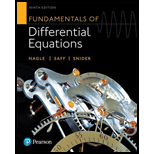
Fundamentals of Differential Equations (9th Edition)
9th Edition
ISBN: 9780321977069
Author: R. Kent Nagle, Edward B. Saff, Arthur David Snider
Publisher: PEARSON
expand_more
expand_more
format_list_bulleted
Expert Solution & Answer
Want to see the full answer?
Check out a sample textbook solution
Students have asked these similar questions
2
)5. The operator T on a vector space V over Q has as its sequence of invariant factors the sequence
(x-1)3(x-2)5(x-3)2, (x-1)(x-2)(x-3)2, (x-3). Find the Jordan normal form of T.
18
Chapter 7 Solutions
Fundamentals of Differential Equations (9th Edition)
Ch. 7.2 - Prob. 1ECh. 7.2 - Prob. 2ECh. 7.2 - Prob. 20ECh. 7.2 - Prob. 28ECh. 7.2 - Prob. 29ECh. 7.4 - In Problems 110, determine the inverse Laplace...Ch. 7.4 - Prob. 3ECh. 7.4 - Prob. 5ECh. 7.4 - Prob. 7ECh. 7.4 - Prob. 9E
Ch. 7.4 - Prob. 11ECh. 7.4 - Prob. 13ECh. 7.4 - In Problems 1120, determine the partial fraction...Ch. 7.4 - Prob. 17ECh. 7.4 - Prob. 19ECh. 7.4 - Prob. 21ECh. 7.4 - Prob. 23ECh. 7.4 - Prob. 25ECh. 7.5 - Prob. 1ECh. 7.5 - Prob. 3ECh. 7.5 - Prob. 5ECh. 7.5 - Prob. 7ECh. 7.5 - Prob. 9ECh. 7.5 - Prob. 11ECh. 7.5 - Prob. 13ECh. 7.5 - Prob. 25ECh. 7.5 - Prob. 27ECh. 7.5 - Prob. 33ECh. 7.5 - Prob. 35ECh. 7.6 - In Problems 14, sketch the graph of the given...Ch. 7.6 - Prob. 3ECh. 7.6 - In Problems 510, express the given function using...Ch. 7.6 - Prob. 7ECh. 7.6 - Prob. 11ECh. 7.6 - Prob. 17ECh. 7.6 - Prob. 19ECh. 7.8 - Prob. 1ECh. 7.8 - Prob. 3ECh. 7.8 - Prob. 5ECh. 7.8 - Prob. 23ECh. 7.10 - In Problems 119, use the method of Laplace...Ch. 7.10 - Prob. 3ECh. 7.10 - Prob. 5ECh. 7.10 - Prob. 7ECh. 7.10 - Prob. 9ECh. 7.10 - Prob. 11ECh. 7.10 - Prob. 13ECh. 7.10 - Prob. 15ECh. 7.10 - Prob. 17ECh. 7.10 - Prob. 19E
Knowledge Booster
Learn more about
Need a deep-dive on the concept behind this application? Look no further. Learn more about this topic, advanced-math and related others by exploring similar questions and additional content below.Similar questions
arrow_back_ios
SEE MORE QUESTIONS
arrow_forward_ios
Recommended textbooks for you
 Advanced Engineering MathematicsAdvanced MathISBN:9780470458365Author:Erwin KreyszigPublisher:Wiley, John & Sons, Incorporated
Advanced Engineering MathematicsAdvanced MathISBN:9780470458365Author:Erwin KreyszigPublisher:Wiley, John & Sons, Incorporated Numerical Methods for EngineersAdvanced MathISBN:9780073397924Author:Steven C. Chapra Dr., Raymond P. CanalePublisher:McGraw-Hill Education
Numerical Methods for EngineersAdvanced MathISBN:9780073397924Author:Steven C. Chapra Dr., Raymond P. CanalePublisher:McGraw-Hill Education Introductory Mathematics for Engineering Applicat...Advanced MathISBN:9781118141809Author:Nathan KlingbeilPublisher:WILEY
Introductory Mathematics for Engineering Applicat...Advanced MathISBN:9781118141809Author:Nathan KlingbeilPublisher:WILEY Mathematics For Machine TechnologyAdvanced MathISBN:9781337798310Author:Peterson, John.Publisher:Cengage Learning,
Mathematics For Machine TechnologyAdvanced MathISBN:9781337798310Author:Peterson, John.Publisher:Cengage Learning,


Advanced Engineering Mathematics
Advanced Math
ISBN:9780470458365
Author:Erwin Kreyszig
Publisher:Wiley, John & Sons, Incorporated

Numerical Methods for Engineers
Advanced Math
ISBN:9780073397924
Author:Steven C. Chapra Dr., Raymond P. Canale
Publisher:McGraw-Hill Education

Introductory Mathematics for Engineering Applicat...
Advanced Math
ISBN:9781118141809
Author:Nathan Klingbeil
Publisher:WILEY

Mathematics For Machine Technology
Advanced Math
ISBN:9781337798310
Author:Peterson, John.
Publisher:Cengage Learning,


Intro to the Laplace Transform & Three Examples; Author: Dr. Trefor Bazett;https://www.youtube.com/watch?v=KqokoYr_h1A;License: Standard YouTube License, CC-BY